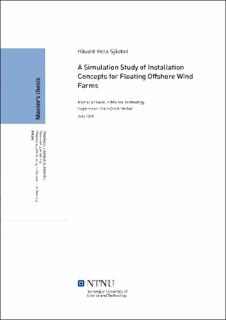| dc.description.abstract | Today, land based wind energy development projects are creating political controversy. An alternative for Norway could be floating offshore wind. We have the areas, and we have the technologies. A challenge is that this solution is estimated to be twice the cost of landbased developments, which may be partly due to a more complex solution for the turbine itself, but may also be because of current low scale production and an inefficient installation logistics. A simulation study is applied to evaluate possible installation logistics for
Floating Offshore wind, as a tool for improving planning and reduce costs.
The total installation cost of an floating offshore wind farm is heavily dependent on weather. Installation during the summer months gives a higher operability compared to the other seasons. The installation should take place during the summer months in order to reduce cost. The report reveals that the towing and hook-up process together with the suction anchor installation are most sensitive to weather and most costly, and these operations should be targeted for developing a better solution rather than simply employing vessels
with increased operating capacity.
Furthermore, the report reveals that the installation logistics for Floating Offshore Wind Farms should include modular vessels with cable laying and construction capabilities in order to introduce flexibility in planning. The simulation study shows that the vessel with modular capabilities is more expensive than the conventional fleet, but by reviewing previous installation projects, it is predicted that it will reduce the total installation cost, considering disturbances in the supply chain. Introducing feeder vessels to the installation logistics is beneficial when the distance from shore increases. The utilization of installation vessels increases and it highlights the importance of not using high-charter cost vessels for sailing back and forth from the wind farm.
Cost adds linearly with wind farm size. The distance from shore highly influence the cost, and removing the number of transport legs between the assembly port and the wind farm is the first step towards cost reduction. Increasing the number of towed floating offshore wind turbines from one to four per round trip reduces the cost with 60 % for a wind farm size of 100 turbines located 66 nautical miles from shore. | |
